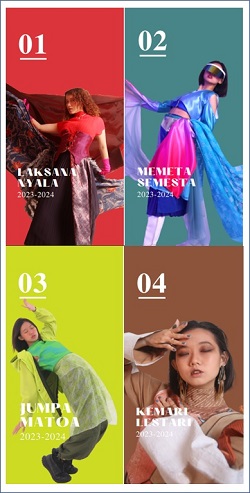The reduced income due to the pandemic has made the thrifting trend a new alternative income for used clothing traders in the midst of the pandemic.
Thrifting is the act of buying used goods that are still suitable for use in order to save expenses.
This trend can also reduce textile waste. This thrifting trend has also become a new breath for traders in Pasar Senen, Central Jakarta, who have continued to lose money since two fires occurred.
To deal with purchases at stores that have fallen sharply, especially since there was a pandemic, shops in the market have started selling their products through online shops.
This was conveyed by Tedy, who runs a used clothing business by capturing his friends who were laid off.
"I open this to help friends who are unemployed, but I prioritize those who have families but have no income," said Tedy.
According to him, in the midst of the Covid-19 pandemic, one of the businesses that was able to survive was thrifting, because the goods being sold were affordable with people's purchasing power.
"This is the most sustainable business because their purchasing power is still capable," said Tedy.
With prices that are much cheaper than new clothes, this young man from Parung, Bogor admits that he still makes a profit. The amount, he said, is sufficient to meet daily needs.
"Alhamdullilah, it's closed because the stall is universal, so it's different from online. If you're looking for a profit of Rp. 100,000-Rp. 200,000, you will find money for food and reduce unemployment," he said.
Meanwhile, Dimas, the owner of a thrift shop, also admitted that his income increased from online sales.
"More online because of the corona situation, they are sitting comfortably at home until they play online, because people now think it's a distance of Rp. 10,000 - Rp. 20,000, it's better to go online, the fees to Monday are all sorts of things," he explained.
If you look at the character of his loyal buyers, Dimas said female customers prioritize the quality of materials, rather than brands.
Meanwhile, male customers are more selective in choosing the products to be purchased, such as looking at the brands being sold.
"Men are looking for hard-to-find items and brands like Zara, Tomy Hilfiger, yes, brands and above. The quality for boys is different from that for girls, the quality is also different," he explained
With the emergence of the thrifting phenomenon which has become a new business for the community, traders want the regulations that prohibit the import of used clothing to be revoked.
The prohibition on the import of used clothing has previously been regulated in the Minister of Trade Regulation Number 51/M-DAG/PER/7/2015. The prohibition is also contained in Law Number 8 of 1999 concerning Consumer Protection (UUPK) and Law Number 7 of 2014 concerning Trade. In the regulation, the import of used clothes is prohibited on the grounds of protecting the health and safety of humans, animals, fish, plants, and the environment.
"The point is that the government is helping us so that we can reduce the price, and even if it is withdrawn we will be subject to tax, so we will talk to the government first," said one supplier of used clothing, Pangaribuan.
The reason is, he sees that in developed countries there are already special thrifting markets such as in Italy, England, and Belgium. Pangaribuan said the benefits he got were also quite a lot during this pandemic because the thrifting phenomenon was popular.
The increase is 30-50 percent of the selling price. He has also supplied to many used clothing stores throughout Indonesia.
"The increase is significant, 30 percent to 50 percent. Those who buy are almost all over Indonesia and send them to eastern Indonesia and to Aceh," he explained.
He took the used clothes from several countries such as Malaysia, Japan, South Korea, and Australia.
The selling price offered varies from Rp. 3,000,000 to Rp. 6,000,000 per bale. "There are thick items, there are thin items depending on the quality, there are grades A, B, C, the shirt or dress is the most expensive," said Pangaribuan.





